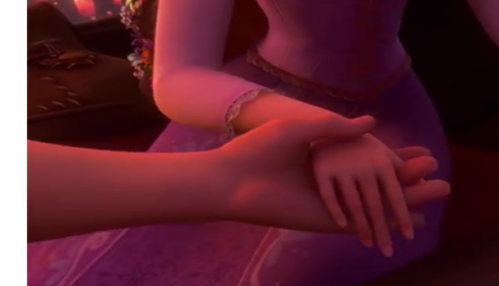Sitting through Disney’s Tangled again, I saw new layers of gender in there. They’ve moved beyond the old-fashioned problem of passive princesses and active princes, so Rapunzel has plenty of action sequences. And it’s not all about falling in love (at least at first). Fine.
But how about sexual dimorphism? In bathroom icons the tendency to differentiate male and female bodies is obvious. In anthropomorphized animal stories its a convenient fiction. But in social science it’s a hazardous concept that reduces social processes to an imagined biological essence.
In Tangled, the hero and heroine are apparently the more human characters, whose love story unfolds amidst a cast of exaggerated cartoons, including many giant ghoulish men (the billed cast includes the voices of 12 men and three women).
Making the main characters more normally-human looking (normal in the statistical sense) is a nice way of encouraging children to imagine themselves surrounded by a magical wonderland, which has a long tradition in children’s literature: from Alice in Wonderland to Where the Wild Things Are.
That’s what I was thinking. But then they went in for the lovey-dovey closeup toward the end, and I had to pause the video:
Their total relative size is pretty normal, with him a few inches taller. But look at their eyes: Hers are at least twice as big. And look at their hands and arms: his are more than twice as wide. Look closer at their hands:
Now she is a tiny child and he is a gentle giant. In fact, his wrist appears to be almost as wide as her waist (although it is a little closer to the viewer).
In short, what looks like normal humanity – anchoring fantasy in a cocoon of reality – contains its own fantastical exaggeration.
The patriarchal norm of bigger, stronger men paired up with smaller, weaker women, is a staple of royalty myth-making – which is its own modern fantasy-within-reality creation. (Diana was actually taller than Charles, at least when she wore heels .)
In this, Tangled is subtler than the old Disney, but it seems no less powerful.
Philip N. Cohen is a professor of sociology at the University of Maryland, College Park, and writes the blog Family Inequality. You can follow him on Twitter or Facebook.




Comments 24
hopeless shade — May 30, 2012
Augh her eyes why?!
Elena — May 30, 2012
Re: Eyes, it's one of the rules of cartoon drawing that when the eyes are bigger (in a big, round head) and positioned lower in the head, they look closer to the proportions of babies or puppies, and the result is terribly cute. The bigger the eyes, the more childlike and appealing. Also, it does not hurt that big eyes are more expressive and show better emotions.
Seriously, pick *any* book about cartoon or manga drawing. Big doe-like eyes = cuteness. To the max, if needed.
As for the rest of cartoon dimorphism, notice how her waist is almost as thin as her neck...
Liz Bloodbath — May 30, 2012
Animation is all about exaggeration
casey — May 30, 2012
Where did the whole royalty thing come from? Aren't there a bunch of examples that aren't royalty? Kinda weird.
Andrew — May 30, 2012
One alternative take on this: aside from merely reinforcing an exaggerated gender binary, I think the childlike proportions here could be intended to coax the intended audience (pre-adolescent girls) into relating strongly to the heroine.
This is the creepy underbelly of romance plots designed for children below dating age. At least one of the leads has to be an age-appropriate audience surrogate despite having physically (and, let's face it, sexually) mature features. What archetype would the romantic fantasy ideal of a grade-school age girl embody? In the eyes of the animators, apparently hybrid of smitten peer and father figure. A safe, comfortable pillar of strength whose power and privilege a wily heroine can harness.
To render Rapunzel and the prince as physical equals would be very progressive, but it would undermine quite a bit of the subtext. Rapunzel is not a representation of an actual teenager, but rather one of a much younger girl in the audience imagining herself as a young woman.
(Not saying it isn't retrograde, of course; we very well should challenge the fact that young girls are still getting fairy-taled into believing their most important task is to capture a powerful man, despite being ostensibly capable of doing just fine without one).
Aubrie L'rai Johnson — May 30, 2012
For a moment, I was prepared to dispute your point with personal evidence -- I am a petite woman, and my boyfriend's wrist is over twice the size of mine, etc. -- until I backed up and reread the post. Yes, it's a cartoon, and the characters are a bit exaggerated, but at the same time, Flynn looks proportionally realistic, whereas Rapunzel's features are small, cute, fragile; dare I say, infantilized.
Thanks to Disney's massive contributions to my childhood experience, I'm always going to at least try to defend them. I mean, they've come a long way from drawing passive princesses cleaning and singing with the birds, waiting for a prince. But damned if they're not consistently contributing negatively to body and relationship dynamics between girls and boys.
Emma — May 31, 2012
Yes, their hands do look particularly out of proportion. I agree with the points about cuteness and infantilization.
However, if you look at images from Tangled there does seem to be some variation in Flynn and Rapunzel's relative proportions. In some images their eyes appear to be about the same size: http://tinyurl.com/crrbgg9 and
http://tinyurl.com/c5v67g9. The image in the original post shows a romantic moment between the characters so it looks like possibly the artists have exaggerated the stereotypical differences between the male and female characters even more, to emphasise the differences for that romantic scene. It's also interesting that Mother Gothel has very big eyes too, although she is obviously not being presented as cute. I can't work out quite what is going on there.
anon — June 1, 2012
Her eyes seriously freak me out.
Alex Odell — June 10, 2012
Anime doesn't equal Disney style though, because honestly, these days they draw all their characters with big eyes and tiny noses, males and females. Animes often have bishounens too, idealized "pretty boys", which blurs the line between the way they draw males and females even more. But with Disney, it's only ever the females that are drawn that way, with the guys looking far more realistic.
Roy Snep — June 28, 2012
It's just magical!!
www.tattoo-designs.nl
AlsnB — July 18, 2012
I am so happy to find this post! I have a song from the Tangled soundtrack and I can't help but think about the weird gender discrepancies every time the album art pops up.
Leaving aside the giant differences in their eyes, irises, pupils, eyebrows, I just keep noticing how the whole lower half of her face is shortened almost to the length of his nose. I know in art shortening the lower proportions of the face is how you move from adult to child to infant. So they've essentially given her a baby face. That's kind of a weird thing to think about.
"jerkface" — January 3, 2014
I really dont see what the problem is. So female disney characters are drawn in an extremely dainty way who gives a damn?! Honestly when i mentally picture a prince and princess i see them as a gentle looking princess and a stronger male counterpart. I know that when i comment people will freak out but..i wouldnt see a movie with a chunky princess and a ugly prince. im sorry i understand that youll think im vain and a pig. Girls strive to look like disney characters because they are roll models, is it such a bad thing for them to want to be thin and girlie?
Ricardo Narvaez — April 4, 2016
Social scientists mainly focus on the interaction these characters have with each other and the consequences that interaction brings whether its positive or negative. It is concerning to the social scientist/ instructor community that the entity Disney has such a strong influence in children's lives at a young age. Another concerning note is Disney conditioning the minds of theses young children towards the ideal life as a princess and the royalty myth making as Cohen mentions. His strong argument consisted of the engendered exaggerations of the body with the princess and her waist. Many of the social scientist community are concerned of the cycle of dimorphism that may be reoccurring thus further perpetuating this conditioning of what the ideal female body should be to young girls at a young age.
Jordan — November 10, 2019
Big eyes, big round head, low position of the eyes so the female star resembles a baby or a cute puppy...why are we making a grown women the exact same as a baby or a puppy? Is that what men want? Are adult women so gross and unappealing...even a young adult woman, that they must be draw in a babyish way in order for us to like them? Is this what adult women wish...that they could remain a giant baby (or "puppy-like") so they can be relevant in a society that will not accept them if they do not possess an infantilized face? And no one thinks this is just a bit...sick? Equality? Nah....guess what ladies? You're going BACKWARDS!!!!